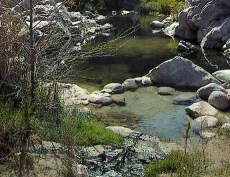What is Naegleria?
Naegleria is a free-living ameba commonly found in the environment in water and soil. Only one species of Naegleria has been found to infect humans, Naegleria fowleri.
Where is Naegleria found?
Naegleria fowleri is found worldwide. Most commonly, the ameba is found in:
Warm bodies of freshwater, such as lakes, rivers
Geothermal water such as hot springs
Warm water discharge from industrial plants
Poorly maintained and minimally chlorinated swimming pools
Soil
How common is Naegleria infection?
Although Naegleria is commonly found in the environment, infection occurs rarely. Only 23 infections were documented in the U.S. between 1995 and 2004.
When is Naegleria most common?
Infection with Naegleria is very rare. However, when it does occur, infection is most common during the dry, summer months, when the air temperature is hot, the water is warm, and water levels are low. The number of infections increase during years characterized by heat waves.
How does infection with Naegleria occur?
Infection with Naegleria occurs when the ameba enters the body through the nose. Generally this occurs when people are participating in water-related activities such as swimming underwater, diving, or other water sports that result in water going up the nose. The ameba then travels to the brain and spinal cord where it destroys the brain tissue.
What are the signs and symptoms of Naegleria infection?
Infection with Naegleria causes the disease primary amebic meningoencephalitis (PAM), a brain inflammation, which leads to the destruction of brain tissue.
Initial signs and symptoms of PAM start 1 to 14 days after infection. These symptoms include headache, fever, nausea, vomiting, and stiff neck. As the amebae cause more extensive destruction of brain tissue this leads to confusion, lack of attention to people and surroundings, loss of balance, seizures, and hallucinations. After the onset of symptoms, the disease progresses rapidly and usually results in death within 3 to 7 days.
What should I do if I have been swimming or playing in freshwater and now think I have symptoms associated with Naegleria?
Infection with Naegleria is very rare and the early symptoms associated with Naegleria may actually be caused by other more common illnesses, such as meningitis. To ensure prompt treatment, people should seek medical care immediately if they develop a sudden onset of two or more of the early symptoms (e.g., fever, headache, stiff neck) at the same time or if symptoms are unusually severe.
Is there treatment for infection with Naegleria?
Several drugs are effective against Naegleria in the laboratory. However, although a variety of treatments have been used to treat infected persons, their effectiveness is unclear since most infections have still been fatal.
Can infection be spread from person-to-person?
No. Naegleria infection cannot be spread from person-to-person contact.
How can I reduce the risk of infection with Naegleria?
Naegleria is found in many freshwater lakes and rivers in the United States, particularly in southern tier states. Therefore, it is likely that a low risk of Naegleria infection will always be associated with swimming in warm freshwater lakes, rivers, and hot springs. Some measures that may reduce this risk include:
Avoid swimming or jumping into bodies of warm freshwater, hot springs, and thermally-polluted water such a water around power plants.
Avoid swimming or jumping into freshwater during periods of high temperature and low water volume.
Hold the nose shut or use nose clips when jumping or diving into bodies of warm freshwater such as lakes, rivers, or hot springs.
Avoid digging in or stirring up the sediment while swimming in shallow, warm freshwater areas.
Do not swim in areas posted as "no swimming" or in areas warning about an increased risk of Naegleria infection.
For further information on protecting yourself from recreational water illnesses, go to http://www.cdc.gov/healthyswimming.
Can I get Naegleria infection from a swimming pool?
No. You cannot get Naegleria infection from a swimming pool as long as the pool is properly cleaned, maintained, and chlorinated.
Re: damned Amoeba strikes again: story
All posts are those of the individual authors and the owner
of this site does not endorse them. Content should be considered opinion
and not fact until verified independently.
| Subject | Author | Views | Posted |
|---|---|---|---|
| jobe | 1600 | September 26, 2007 11:13PM | |
| Paul P. | 1151 | September 27, 2007 10:52AM | |
| Rick | 982 | September 27, 2007 12:14PM | |
| Paul P. | 941 | September 28, 2007 09:18AM | |
| LaughingBear | 986 | September 28, 2007 04:54PM | |
| celtfire | 949 | September 29, 2007 09:06AM | |
| celtfire | 1077 | September 29, 2007 09:15AM | |
| Rick | 5283 | September 29, 2007 02:34PM | |
| Rick | 943 | October 26, 2007 04:26PM | |
| Paul P. | 953 | September 30, 2007 09:17AM | |
| jobe | 881 | October 02, 2007 05:31PM | |
| Rick | 1824 | November 25, 2007 05:01PM |
Sorry, only registered users may post in this forum.





